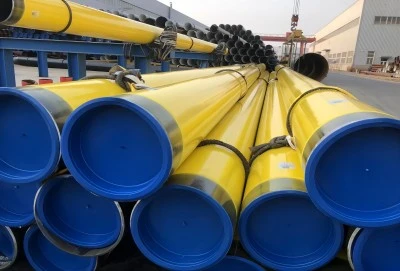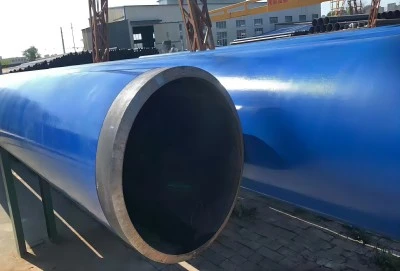PE coated steel pipe undergoes a sophisticated process to enhance its durability and performance. The procedure involves applying a protective polyethylene (PE) layer to the exterior of steel pipes, significantly improving their resistance to corrosion, abrasion, and environmental factors. This coating process is crucial for industries such as oil and gas transportation, water supply systems, and offshore platform construction, where pipe integrity is paramount. The PE coating acts as a barrier, extending the lifespan of steel pipes and ensuring the safe transport of fluids across various challenging environments.
|
|
|
Step-by-step guide: PE coating application process
Surface preparation: Cleaning and blasting
The initial step in the PE coated steel pipe process is meticulous surface preparation. This phase is critical as it directly impacts the coating's adhesion and overall effectiveness. The steel pipe's surface undergoes thorough cleaning to remove any contaminants, such as dirt, oil, or rust. Following this, the pipe is subjected to abrasive blasting, typically using materials like steel grit or sand. This blasting creates a roughened surface profile, enhancing the coating's ability to bond with the steel.
Applying primer layer for enhanced adhesion
After surface preparation, a primer layer is applied to the steel pipe. This primer, often an epoxy-based compound, serves as a crucial intermediary between the steel surface and the PE coating. It not only improves adhesion but also provides an additional layer of corrosion protection. The primer application is typically done through spraying or dipping methods, ensuring an even and consistent layer across the pipe's surface.
PE coating application and curing techniques
The final stage involves the application of the PE coating itself. This is usually done through extrusion, where molten polyethylene is applied directly onto the primed pipe surface. The thickness of the coating can be adjusted based on the specific requirements of the project. Following application, the coated pipe undergoes a controlled cooling process to ensure proper curing and adhesion of the PE layer. This curing process is crucial for achieving the desired properties of the coating, including its strength and durability.
Advanced techniques in PE pipe coating
3-layer PE coating: FBE, adhesive, and PE layersAn advanced method in PE pipe coating is the 3-layer system. This technique combines three distinct layers for superior protection: Fusion Bonded Epoxy (FBE), an adhesive layer, and the outer PE coating. The FBE layer provides excellent corrosion resistance and bonds well with the steel surface. The adhesive layer, typically a copolymer, ensures strong adhesion between the FBE and the PE coating. This multi-layer approach offers enhanced protection against mechanical damage and chemical corrosion, making it ideal for demanding applications in harsh environments.
High-density vs. low-density PE coating options
The choice between high-density polyethylene (HDPE) and low-density polyethylene (LDPE) coatings depends on the specific requirements of the project. HDPE coatings offer superior strength, chemical resistance, and temperature tolerance, making them suitable for high-stress environments. LDPE coatings, while less robust, provide excellent flexibility and are often more cost-effective. The selection between these options is influenced by factors such as operating temperature, chemical exposure, and mechanical stress levels expected in the pipe's intended application.
Automated coating systems for improved efficiency
Modern PE coated steel pipe processes increasingly utilize automated systems to enhance efficiency and consistency. These systems employ advanced technologies such as robotic arms for coating application, automated surface preparation units, and computer-controlled curing chambers. Automation not only improves the speed of the coating process but also ensures uniform application and thickness control. This results in higher quality coatings with fewer defects, crucial for maintaining the integrity of pipelines in critical infrastructure projects.
Quality control measures in PE coating process
Thickness measurement and uniformity checksEnsuring the correct and uniform thickness of the PE coated steel pipe is crucial for its effectiveness. Quality control measures include the use of advanced thickness gauges, such as electromagnetic or ultrasonic devices, to measure coating thickness at multiple points along the pipe. These measurements are conducted both during and after the coating process to ensure compliance with specified standards. Uniformity checks involve visual inspections and automated scanning systems to detect any irregularities or thin spots in the coating, which could compromise the pipe's protection.
Adhesion testing for long-term durability
The strength of the bond between the PE coating and the steel pipe is critical for long-term performance. Adhesion tests are conducted to evaluate this bond strength. Common methods include the peel test, where a section of the coating is peeled back at a specific angle and rate, and the cathodic disbondment test, which simulates long-term exposure to cathodic protection systems. These tests help predict the coating's ability to withstand environmental stresses and maintain its protective properties over time.
Corrosion resistance evaluation methods
Evaluating the corrosion resistance of PE coated steel pipes involves several specialized tests. Salt spray tests simulate marine or coastal environments, exposing coated samples to salt-laden mist for extended periods. Immersion tests in various chemical solutions assess the coating's resistance to specific corrosive agents. Additionally, electrochemical impedance spectroscopy (EIS) is used to measure the coating's barrier properties and detect any microscopic defects that could lead to corrosion. These comprehensive evaluations ensure that the PE coating will provide effective protection in its intended operational environment.
The PE coated steel pipe process for steel pipes is a complex yet crucial procedure that significantly enhances their durability and performance. From meticulous surface preparation to advanced application techniques and rigorous quality control, each step plays a vital role in creating a protective barrier that withstands harsh environments. As industries continue to demand more from their pipeline infrastructure, the importance of high-quality PE coatings cannot be overstated. By understanding and implementing these advanced coating processes, engineers and project managers can ensure the longevity and reliability of their pipeline systems, contributing to safer and more efficient operations across various sectors.
PE Coated Steel Pipe Supplier
Hebei Longma Group stands out as a premier supplier of PE coated steel pipes, offering a comprehensive range of solutions for diverse industrial applications. With advanced production equipment imported from Germany and independently developed technologies, Longma ensures top-quality products. Our professional team of over 300 employees, including 60+ technical experts, drives innovation and maintains high standards. We boast comprehensive testing facilities, including ultrasonic flaw detectors and industrial X-ray equipment, ensuring product integrity. Longma's fast delivery capability, with standard thickness pipes produced in just 7 days, sets us apart in the industry. We hold complete certifications, including API 5L, ISO 9001, ISO 14001, and more, demonstrating our commitment to quality and environmental standards. Our competitive pricing is achieved through stable raw material partnerships and an efficient, integrated production model. For steel pipes meeting API 5L, ASTM A53, EN10210, AS/NZS 1163 standards, with coating standards including DIN 30670, DIN30678, CSAZ245.20, EN10339, ISO21809-1, AWWAC210, C213, and available in 60.3-1422mm outer diameter and 6.02-50.8mm wall thickness, contact us at info@longma-group.com.














